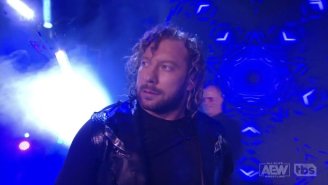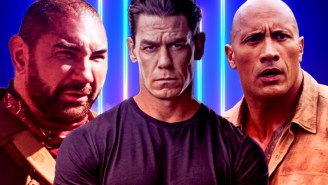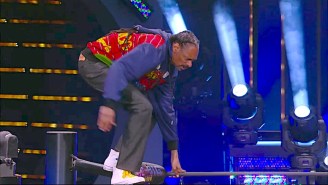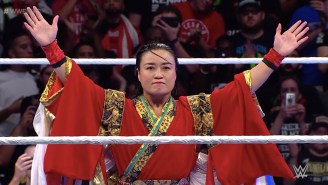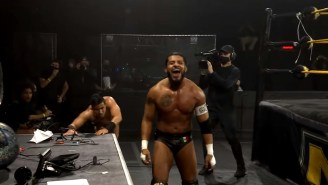Initially this was just supposed to be a puff piece: one of those image-centric, easy to write-easy to read listicles that everybody says they hate but just can’t stop themselves from reading. But, you know, I’m me, and I’m really truly terrible when it comes to distilling things I’m passionate about into tiny blurbs. The thing is, it’s very easy to fantasy book existing rosters, especially if you’re me and you just want everything to turn into wacky road trip adventures and eighties-style teen movie-meets-Rodney Dangerfield shenanigans without the misogyny and unfortunate racist bents. Everybody has their ideas about what would ‘fix’ what they see as being wrong with any wrestling company, and you’re lying if you say you don’t have an opinion on what you wish wrestling could do to be better. All of these things lead to a very sad truth when it comes to women in WWE: we’re not going to get what we want.
If you’ve been paying attention to recent signings, or Brandon’s Best and Worst of NXT columns (you should, they’re great), you can see a growing trend in the kind of future we’re to have, and it’s covered in glitter and the canonical height of Hello Kitty (three apples, for those of us who aren’t my friend Chris Sims). When you start to realistically think about women who could potentially work in NXT and eventually go on to graduate to the hellscape that is the main roster, it mutates your brain into this unexpectedly hypercritical monster. Looking at women through the WWE lens proves more than anything just how flawed that view is.
Go ahead and try it. Think long and hard about the women you love to watch wrestle, and then put them into the context of televised wrestling. Ignore, for a moment, their actual wrestling talent; I think we’ve seen beyond a shadow of a doubt that’s not what gets you there. It’s easier when you realize just how irrelevant that is, whether it’s because of the track record of women not being given a chance to really wrestle, or the very real examples of women starting out slow, then working hard and forcing themselves into the NXT spotlight. Starting green and training and improving isn’t a bad thing – quite the opposite, in fact. But you really have to think long and hard about where they’re training to go.
When you start thinking about the criteria for women to be successful in WWE, you have to consider what they want women to be: trainable, beautiful, athletic but not too boyish, and most importantly, someone they can mold into a brand. All WWE Superstars are a brand. John Cena is the most immediate example, but all of them are wrestlers second, personalities first. Can you be put into a movie? Are you someone TMZ would care about? Are you subversive enough to appeal to the “internet fans” without alienating a more casual demographic? How would they look on the cover of a fitness magazine? Would I like you, but more importantly, would my mom like you? Nobody is going to be the next Rock or Stone Cold, but standards are low enough for someone else to be the next Kelly Kelly.
Are you still thinking about who you want to see move out of the indies and into developmental? How many wrestlers have you eliminated? Now why have you taken them out of the running? Are they too old? Too “big”? This one would need to tone up more. That one has a weird snaggle tooth. This one isn’t “TV pretty.” Those two are great and have loads of potential but are in shape to the point of looking like Sexy Lady Scott Steiners (my new dream tag team FYI). Things that wouldn’t disqualify anyone from being conventionally attractive in the real world prove to be untenable in the fundamentally broken criteria of the entertainment industry. We want Sleater Kinney, but our future is Candy-era Mandy Moore.
Now think of everything you love about the women of NXT, or better yet, go back and read about why I love them. Sasha Banks is so important to me for so many reasons. If Bayley constantly tweeted about how amazing Ice-T is on Law & Order: SVU and adopted a plant-based diet she would be Me: The Wrestler. I can never be anything that Charlotte is, but I’m constantly in awe of what she started out as, and what she turned into. Becky Lynch is basically a gender-swapped Sheamus highschool AU character who’s going through a rebellious stage and can’t seem to fit in anywhere, and it’s flippin’ fantastic. But none of these things we love are what they were supposed to be. NXT gets to be this magical place where we think wrestling matters and personality rules, but like any developmental arena, accidents happen. Play-Doh was invented to be a wallpaper cleaner. Listerine went through three or four uses, from cigarettes to dandruff treatments, before being that thing I always buy but forget to regularly incorporate into my daily dental hygiene routine (don’t judge me, you know that statement is real as hell). We love what we have, but what we have was never supposed to happen.
Like I said in the beginning, this was supposed to be a simple list: here are five women I would love to see in a Full Sail ring. As I tried to narrow down my list, that lizard brain went into overdrive, and couldn’t stop thinking about why they wouldn’t work. The more I thought about it, the more frustrated I got because these superficial reasons are so intensely stupid. I would kill for someone like Evie to be on TV every week. Veda Scott is a Total Package in my book, both from my incredibly biased viewpoint and the perspective of how well she already works on a TV show that few people actually get to (or care to) watch. Jessica James is the size of an orange pip but is a shoot black belt and could probably kill you with her thumbs if she wanted to. Candice LeRae is a tiny little powerhouse who is gorgeous as heck and can hang in the ring better than most dudes on the indies, and she proves it every chance she gets. If WWE’s goal is to sign girls the size of Ariana Grande to feed to our future ideal Diva of Alexa Bliss, where does that leave someone like Vanessa Kraven? Or the still incredibly tiny but incredibly strong Kimber Lee? Better yet, what kind of future belongs to the women we already love?
Women like Alexa Bliss are important – let’s not discount that. When we start discounting people who do fit the mold of what WWE wants, we remove both their agency and their worth, and that’s counterproductive to the conversation we should be having. Removing Bliss’s glitter was devastating enough. But we also know that having one kind of woman be the definition of a Diva does not work. Who do you think of when you think of a “bad Diva?” I’ll bet you anything that she’s that WWE ideal. I am also willing to bet that most people’s opinions are the result of never being given a chance to be more than the person on the cover of Maxim. They were never looking for someone to be the next Moolah, or the next Alundra Blayze, and you sure as hell know they were never looking for the next Luna Vachon.
But they should be.
Anyone with a modicum of real-world sense knows that diversity is important. Look at the popularity of comics like Gotham Academy, Ms. Marvel, or Lumberjanes. People of every identifiable gender are flocking to books like Bitch Planet, where non-compliance and strong, diverse women are the norm. The world is changing, and our paragons of pop culture are slowly starting to play catch-up, despite sometimes overwhelming backlash from people with terrible world views. My entire pull list has books with at least one female creator. Do you understand how unfathomable that still is? Kamala Khan is a voice for teen girls, for Muslim girls, or for anyone who has had a responsibility thrust upon them before they were ready. Any one of those as a central concept is amazing. And the numbers are there. The money is there. So what does it take to make that bleed into other things that I love?
I wish I had the answer. I wish there was some magical paragraph I could produce that would make people sit up and say hey, we have twenty different male archetypes, why do we only get women on who operate within the Madonna-Whore complex on the main stage? I wish that if they did say that, it would matter. I wish Divas were given a chance instead of confused fumbling the unfortunately-named Rack Attack. I wish Frenemies could be stricken from the WWE lexicon and the WWE announce team could be shot into the sun. Women licking each other and grinding on their downed opponents is not queer representation. Total Divas is not definitive “way to get your woman to watch wrestling.”
A little while ago, a friend asked why there don’t seem to be more women fans of women’s wrestling. I saw the convoluted answers, the mansplaining, the rationalizing, but nobody really seemed to pick up on one simple, sad truth: Wrestling is not made for us. Companies like SHIMMER and Shine live on the tip of everyone’s tongue because they assume that all-women equals pro-women. But have you ever been in the audience for an all-female show, be it an Ybor City sausagefest, or a one-off night of women’s matches in a male-centric organization? I can think of two of the most uncomfortable experiences I’ve ever had at a wrestling show, and they were both shows solely dedicated to female performers. Tips for going to your first SHIMMER show read like giving someone advice on going to a petting zoo for the first time: don’t make any sudden movements at the performers, bring them something they like. They basically stop short of saying “keep your palm flat when feeding the talent so they stay calm and don’t bite.” DVDs receive a higher price, individually-priced intergender matches are a few dollars higher than same-gender bouts. On every level, the seeming celebration of women doesn’t speak to women. There’s an underlying fetishization that keeps women in the ring from every truly belonging to us. WWE is a daily reminder of the worst of this, and if anything is to change, it has to start from the top.
The previous article on the importance of representation was inspired by seeing three powerful, confident women on Saturday Night Live and the reflection on how they influenced me. But there’s a darker side to that. Back in 2011, Jane Curtin and Tina Fey made an appearance on Oprah to talk about their experiences working on the show. Curtin matter-of-factly pointed out the pervasive sexism in the writers room, and now seems to be one of the only people willing to talk about the blatant misogyny that existed, especially from one of it’s worst proponents, John Belushi. You know, the beloved SNL comedian who said that “women are just fundamentally not funny.” Chevy Chase and Dana Carvey shifted uncomfortably in their chairs, trying to deflect with jokes while Tina Fey sat with an almost sad, knowing look on her face. If Curtin couldn’t even get a credit card as a single woman in the Seventies, imagine how hard it was to get a chance to be funny on television? Fey has made it a point to let everyone know that she never felt marginalized during her time at SNL, but did say this:
“By the time I got there in that read-through room, our director was a woman; one of our stage managers was a woman. The more women that were in the room to laugh at the different pieces, then [the more] people were like, ‘Oh, okay, maybe we’ll put it on.'”
If WWE is afraid of taking the risk of booking women to look like everyone else, maybe they should consider that. An increase in women in any aspect broadens the scope of your potential. Heck, look at how respected the very idea of Sara Del Rey as a trainer/road agent is. People love the idea that Stephanie McMahon is a no-nonsense woman in power. So what do we have in between?
The entire idea of marketing to the female “pre-teen” demographic was built on the idea that young girls had expendable allowance/babysitting money. The buying power of “tweens” has been estimated at roughly $260 billion, and that’s not even a recent estimate. $9 billion of that comes from girls buying make-up and skincare. Think about that. That’s nine times what WWE is worth as a whole. Now think of what WWE could be worth of the other half of the population was catered to in even the smallest way. Women of all ages have voices. Women have important spheres of influence. Women have spending power. Sure, we may still have a whole lot less than men, but the market is there. The demographic is hungry. But who is there in the room to point that out?
Now, one more time: go back to that first list you formed in your head. Instead of narrowing it down by who works well in the context of television, look at it like this: who would you want to see that represents what you love about being a woman? What do you love about yourself, and do you see that in anyone on that list? If WWE Superstars are prototypical male power fantasies, I want you to ask yourself the question WWE should be asking. Instead of asking “Who do I want to look like,” ask “who do I want to BE like?” “Who would I want my daughter to look up to?” “Who would inspire any woman in my life to feel strong and powerful?” And better yet, “Who is talented and mean enough to make me hate them without using their relation to a man to do it?”
These aren’t unheard of, unattainable things we’re asking for here. We want what we want on any show, in any book, in any movie, in any comic panel: we want us. We want women who don’t just look strong, but are strong in every sense of the word. We want women who have complex emotions, or any emotions without being demonized for it. Being “a crazy chick” is despicable, but being an “unstable” male wrestler is a thing you put on a t-shirt. A t-shirt you sell to women. We want women who aren’t afraid to look silly, but not at the cost of their dignity. We want WWE to take the opportunity they were given to take a risk and try treating women like human beings. To look at the popularity and pure, unadulterated love people have for those women who weren’t supposed to break out and understand that this is the audience that they’re missing out on. To recognize that diversity is an integral part of why people embrace those wrestlers in the way that they do. After the halcyon days of Hulkamania and the Attitude Era, this is the next step. This is the future they can no longer ignore.
Women are the future WWE can’t afford to ignore.

